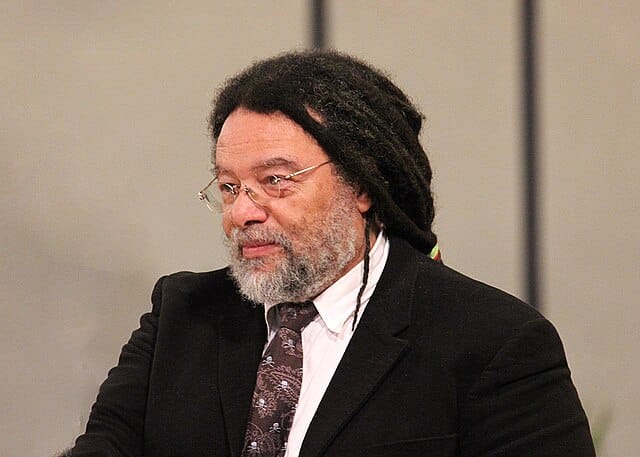Beyond Black and Jewish nationhood
Considering Paul Gilroy’s radical Jewish influences.

Thirty years ago, sociologist Paul Gilroy published his seminal work, The Black Atlantic: Modernity and Double-Consciousness. Widely regarded as groundbreaking, Gilroy’s book transformed critical understanding of modernity – both through problematising modern Europe as the product and producer of racial slavery, and by articulating and celebrating transatlantic Black culture.
Gilroy is now spoken of alongside his late mentor and PhD supervisor Stuart Hall as one of the most significant theorists of contemporary Britain. Cited as an influence by artists such as John Akomfrah and Steve McQueen, Gilroy’s book has inspired major exhibitions – from Tate Liverpool’s Afro Modern: Journeys Through the Black Atlantic to the ongoing digital archival research project, The Black Atlantic Museum. But one aspect of Gilroy’s work that has received less attention is its relationship to Jewish traditions.
In the final chapter of The Black Atlantic, “‘Not a Story to Pass On’: Living Memory and the Slave Sublime”, Gilroy has a revelation: “It is often forgotten that the term ‘diaspora’ comes into the vocabulary of black studies and the practice of pan-Africanist politics from Jewish thought.” Urging the reader to remember this influence, Gilroy asserts the political significance of recognising “diaspora” as an “intercultural” concept.
I don’t aim here to claim Gilroy as a Jew-ish theorist, or to appropriate his notion of the Black Atlantic for the service of Jewish identity. Instead, I want to draw attention to Gilroy’s own response to Jewish texts. To me, Gilroy shows how radical Jewish theories of identity can be taken forward to provide a model of non-national belonging in today’s Britain, for both Jewish and Black communities.
Against European modernity
In Gilroy’s summary, the term “diaspora” enters political thought in the late 19th century, via Jewish theorisation of the biblical term describing the scattering of the Jews among the Gentiles. He positions the “diaspora” concept both as a Jewish cultural response to modern European racism, and as a Jewish response to the development of Zionism. Rereading Gilroy provides another reminder of the longevity of Jewish anti-Zionism, a school of thought with a history as established and traditionally Jewish as Zionism, although you wouldn’t know it from listening to mainstream discourse today.
Citing the cultural critic Ella Shohat, whose work articulates Arab-Jewish identities and interrogates the relationship between Ashkenazi and Sephardi Jews, Gilroy notes the heterogeneity of Jewish traditions – although he does not go on to explore Sephardi, Mizrahi or Black Jewish writing. Gilroy’s account of Jewish thought is personal, not comprehensive.
Gilroy’s main influences are marginal, radical European Jews. He writes: “The contributions from writers whose relationship to Jewish lore and law was remote or ambivalent, have been a rich resource for me in thinking about the problems of identity and difference in the black Atlantic diaspora.” He cites some of the ambivalent thinkers to whom he has been “repeatedly drawn”: Walter Benjamin, Theodor Adorno, Georg Lukács – cultural theorists whose works offer a de-essentialized language of diasporic Jewish identity, based on their own (varied) experiences of exile and assimilation.
Gilroy notes briefly that the significance of Jewishness for these figures has been subject to debate, but he doesn’t re-open the question; for him (as for myself), it is enough that they feel Jewish.
Responding to Jewish diasporic resistance to the idea of a Jewish state, Gilroy traces the overlapping traditions of Zionism and 19th-century Afrocentrism as political movements originating in response to conditions of oppression within the modern European nation state. His concept of the Black Atlantic resists the formation of a nation and the idea of an imagined “return” to the source, critiquing these separate moves towards nation statehood, Black or Jewish. Gilroy’s Black Atlantic exists in relation to the conditions created by white racism and nationalism, without reifying race or nationhood.
Gilroy also situates the work of sociologist and civil rights activist W.E.B. Du Bois in dialogue with Jewish experience. In The Souls of Black Folk (1903), Du Bois proposed that African-American identity is dual: the identity of an oppressed group within the society of the oppressor. Du Bois’ concept of double consciousness provides a central vocabulary for Gilroy’s understanding of the Black Atlantic experience.
In 1892, Du Bois received a fellowship to study in Berlin. In between his studies, he travelled around Eastern Europe. Gilroy quotes a passage of Du Bois’ autobiography in which he remembers an encounter: “Arriving one night in a town north of Slovenia, the driver of a rickety cab whispered in my ear, ‘Unter die Juden?’” Passing for Jewish, Du Bois unexpectedly agrees – yes, I am one of the Jews – and finds himself welcomed into a Jewish inn.
The incident is no voyeuristic exercise for Du Bois, but an instinctive, curious acceptance of his own racialization as Jewish. “I was a little frightened as in the gathering twilight I traversed the foothills of the dark Tatras alone and on foot,” he writes. Walking through the shadows of the Slovenian hillside, Du Bois enters into the experience of Ashkenazi-Jewish persecution: his fear recalls the real threats faced by an isolated Jewish traveller in 19th-century Europe.
Gilroy comments that Du Bois “hints” at the influence of his experiences in Europe on his later role in the formalisation of Pan-Africanism in the 20th century, as a political and cultural movement without borders. Du Bois witnessed the complex and frightening dynamics of race in Europe both from the positionality of a Black American and, in this episode, from the position of a European Jew. Staying at a Jewish inn, offered to him as a safe harbour by the eastern-European Jewish diaspora, Du Bois’ identity is de-essentialized and ambiguous.
Like Du Bois himself, Gilroy “puzzles” over this episode, which does not have a straightforward interpretation. For Gilroy, Du Bois’ experience is one example among many that draw a productive parallel between Jewish and Black experiences of European modernity.
Common marginality
It is in this context of shared experience that Gilroy asks about the possibilities of setting “the Holocaust of European Jews in a provocative relationship with the modern history of racial slavery and terror in the western hemisphere.” Gilroy asserts the uniqueness of the Holocaust, and does not seek to compare these events; instead, he positions these histories together as “precious resources” for understanding the ways in which modernity operates.
Gilroy provides a necessary counterweight to a still-too-common discussion pitting traumatic histories against one another in a reductive and damaging hierarchy. Yet by resisting the assumption that communal trauma has to be considered in isolation within each affected community, he shows how solidarity between marginalised groups can be built, through an empathetic understanding of the fact that distinct events can produce overlapping experiences.
An extract from The Black Atlantic is even included in Neil Levi and Michael Rothberg’s critical anthology, The Holocaust: Theoretical Readings. In their introduction, the editors note Gilroy’s indebtedness to theoretical work in Holocaust studies, as well as suggesting that Holocaust scholars can benefit from the questions raised by Gilroy’s project.
Gilroy does not stop at the comment that both Jewish and Black diasporas have faced genocidal violence from modern European nation states; he contends that these events, taken together, are at the core of the modern European nation state in its current form. As he wrote in 1993, and as remains true: “In Europe, the most active and violent proponents of racism focused by colour and phenotype openly draw their inspiration from fascist ideologies” – in other words, if it walks like a racist and talks like a Nazi, it’s both. As a result, any European anti-racist movement has to account for the intersection of anti-Blackness and anti-semitism, in opposition.
Gilroy hoped back then to aid in the development of “a better political relationship between Jews and blacks at some distant future point” – a comment which, depressingly, remains a relevant indictment of white Jewish racism. His “distant” hope assumes new resonance as a warning against the current rise of anti-solidarity Jewish identity politics in Britain – not only in terms of support for the far right government in Israel, but also in terms of discourses that segregate anti-semitism from other racisms.
Gilroy’s is therefore a necessary text for anyone who wants to find an alternative language for articulating the mutual concerns of differently racialised communities in the context of Britain’s current political crises. At a time when anti-semitism is being thrown around as a political football, Gilroy reminds us that the position of non-national communities in modern Europe is not, and has never been, a game.
The Black Atlantic is not about Jewish selfhood, and I certainly don’t intend to reduce Gilroy to a theorist of European Jewish identity; the book’s significance is far broader than the select material covered here. But it’s worth remembering the fact that Gilroy’s own intellectual history of the Black Atlantic deliberately foregrounds Jewish writers. This act of intellectual solidarity challenges his readers to think more inclusively and more expansively, resisting mental and national borders.
For Gilroy, members of Black and Jewish diasporas share a capacity to think across boundaries of time and space – not because of an essentialised quality in the bodies of those thinkers, but because of our rich and shared inheritance: a language of transnational belonging.▼
E.K. is a writer and researcher.




